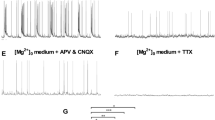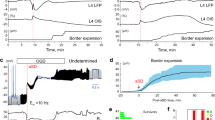Abstract
ACTIVATION of NMDA (N-methyl-D-aspartate) receptors by neurotransmitter glutamate stimulates phospholipase A2 to release arachidonic acid1,2. This second messenger facilitates long-term potentiation of glutamatergic synapses in the hippocampus3, possibly by blocking glutamate uptake4,5. We have studied the effect of arachidonic acid on glutamate uptake into glial cells using the whole-cell patch-clamp technique to monitor the uptake electrically6,7. Micromolar levels of arachidonic acid inhibit glutamate uptake, mainly by reducing the maximum uptake rate with only small effects on the affinity for external glutamate and sodium. On removal of arachidonic acid a rapid (5 minutes) phase of partial recovery is followed by a maintained suppression of uptake lasting at least 20 minutes. Surprisingly, the action of arachidonic acid is unaffected by cyclo-oxygenase or lipoxygenase inhibitors suggesting that it inhibits uptake directly, possibly by increasing membrane fluidity. As blockade of phospholipase A2 prevents the induction of long-term potentiation (LTP) 8, inhibition of glutamate uptake by arachidonic acid may contribute to the increase of synaptic gain that occurs in LTP. During anoxia, release of arachidonic acid9 could severely compromise glutamate uptake and thus contribute to neuronal death.
This is a preview of subscription content, access via your institution
Access options
Subscribe to this journal
Receive 51 print issues and online access
$199.00 per year
only $3.90 per issue
Buy this article
- Purchase on Springer Link
- Instant access to full article PDF
Prices may be subject to local taxes which are calculated during checkout
Similar content being viewed by others
References
Dumuis, A., Sebben, M., Haynes, L., Pin, J.-P. & Bockaert J. Nature 336, 68–70 (1988).
Lazarewicz, J. W., Wroblewski, J. T., Palmer, M. E. & Costa, E. Neuropharmacology 27, 765–769 (1988).
Williams, J. H., Errington, M. L., Lynch, M. A. & Bliss, T. V. P. Nature 341, 739–742 (1989).
Chan, P. H., Kerlan, R. & Fishman, R. A. J. Neurochem. 40, 309–316 (1983).
Yu, A. C. H., Chan, P. H. & Fishman, R. A. J. Neurochem. 47, 1181–1189 (1986).
Brew, H. & Attwell, D. Nature 327, 707–709 (1987).
Barbour, B., Brew, H. & Attwell, D. Nature 335, 433–435 (1988).
Linden, D. J., Sheu, F.-S., Murakami, K. & Routtenberg, A. J. Neurosci. 7, 3783–3792 (1987).
Rehncrona, S., Westerberg, E., Akesson, B. & Siesjö, B. K. J. Neurochem. 38, 84–93 (1982).
Attwell, D. & Sarantis, M. J. Physiol. 415, 40P (1989).
Cull-Candy, S. G., Howe, J. R. & Ogden, D. C. J. Physiol. 400, 189–222 (1988).
Piomelli, D. et al. Nature 328, 38–43 (1987).
Sekiguchi, K., Tsukuda, M., Ase, K., Kikkawa, U. & Nishizuka, Y. J. Biochem. (Tokyo) 103, 759–765 (1988).
Swann, A. C. Arch. Biochem. Biophys. 233, 354–361 (1984).
Le Grimellec, C., Friedlander, G. & Giocondi, M.-C. News physiol. Sci. 3, 227–229 (1988).
Rothman, S. M. & Olney, J. W. Trends Neurosci. 10, 299–302 (1987).
Lynch, M. A., Errington, M. L. & Bliss, T. V. P. Neuroscience 30, 693–701 (1989).
Shiells, R. A., Falk, G. & Naghshineh, S. Proc. Roy. Soc. Lond. B. 227, 121–135 (1986).
Lynch, M. A., Errington, M. L. & Bliss, T. V. P. Neurosci. Lett 62, 123–129 (1985).
Dolphin, A. C., Errington, M. L. & Bliss, T. V. P. Nature 297, 496–498 (1982).
Wong, P. Y. D., Bedwani, J. R. & Cuthbert, A. W. Nature, New. Biol. 238, 27–31 (1972).
Bass, D. A., Flaherty, J. T., Szejda, P., DeChatelet, L. R. & McCall, C. E. Proc. natn. Acad Sci., U.S.A. 77, 5125–5129 (1980).
Ford-Hutchinson, A. W., Bray, M. A. & Smith, M. J. H. J. Pharm. Pharmacol. 31, 868–869 (1979).
Author information
Authors and Affiliations
Rights and permissions
About this article
Cite this article
Barbour, B., Szatkowski, M., Ingledew, N. et al. Arachidonic acid induces a prolonged inhibition of glutamate uptake into glial cells. Nature 342, 918–920 (1989). https://doi.org/10.1038/342918a0
Received:
Accepted:
Issue Date:
DOI: https://doi.org/10.1038/342918a0
This article is cited by
-
Reconstitution of GABA, Glycine and Glutamate Transporters
Neurochemical Research (2022)
-
Metabolomic and lipidomic profile in men with obstructive sleep apnoea: implications for diagnosis and biomarkers of cardiovascular risk
Scientific Reports (2018)
-
Glutamate as a neurotransmitter in the healthy brain
Journal of Neural Transmission (2014)
-
Involvement of NMDA Receptor in the Modulation of Excitatory and Inhibitory Amino Acid Neurotransmitters Release in Cortical Neurons
Neurochemical Research (2010)
-
Phospholipase A2 activation as a therapeutic approach for cognitive enhancement in early-stage Alzheimer disease
Psychopharmacology (2009)
Comments
By submitting a comment you agree to abide by our Terms and Community Guidelines. If you find something abusive or that does not comply with our terms or guidelines please flag it as inappropriate.



